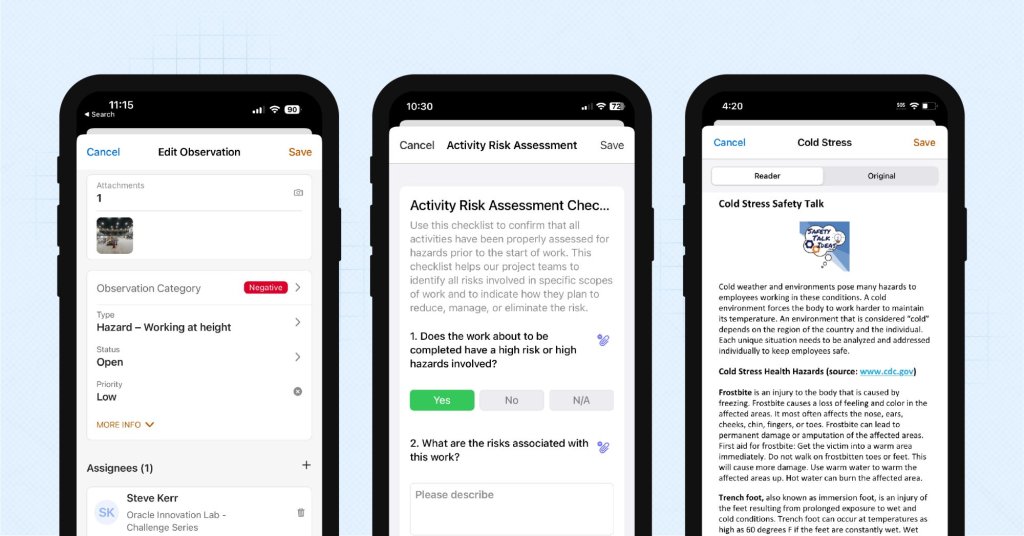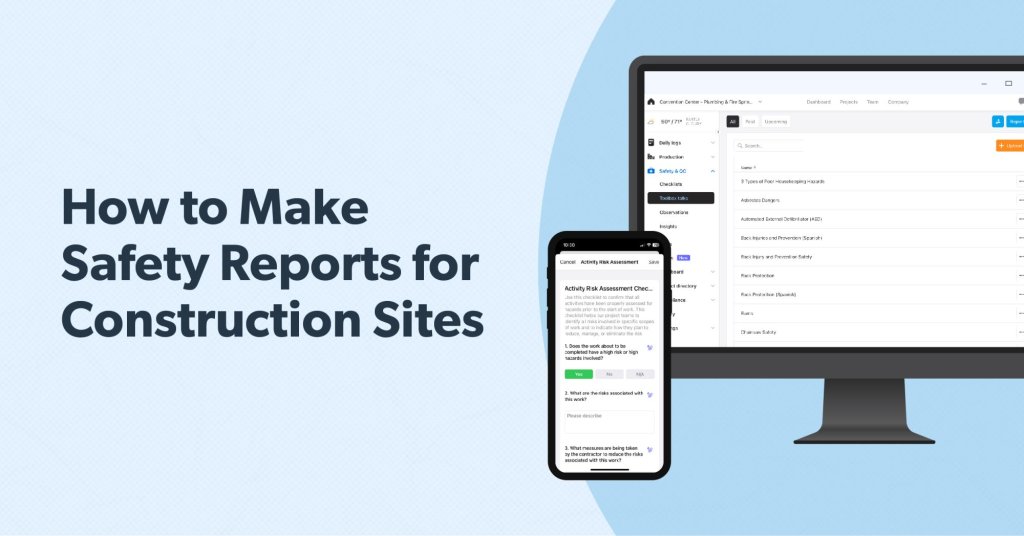Managing safety is a complex process. Construction safety reports improve documentation and help you keep track of effective strategies.
Learn more about construction safety reports and see how to add this simple yet effective tool to your safety plan.
What is a construction site safety report?
A construction site safety report is a comprehensive audit of safety on the jobsite. The goal of a safety report is to proactively identify potential issues and diminish hazards before they lead to incidents.
There is no standardized construction safety report, and the format can vary based on the project’s complexity and other factors—like OSHA requirements. A report may consist of inspections, observations, and recommendations, and it may be made on a daily, weekly, or monthly basis.
Unlike a job hazard analysis, which focuses on reviewing the safety of a specific job or task, construction safety reports address the overall safety concerns of the entire project.
What is included in a construction site safety report?
While the specifics of your project and business will dictate the information you need to include in your safety reports, there are some common areas of concern that apply to nearly every jobsite.
1. Personal protective equipment (PPE)
If you’re on a construction site, you need to wear the proper PPE, even if you aren’t actively working on a task. And, when you’re wearing PPE, you need to be sure you’re using it correctly.
Include a section for auditing PPE use onsite in your construction safety report. This will ensure workers are wearing the right safety gear in the correct manner.
2. Housekeeping
A construction safety report should include a general inspection of the work area. Check to make sure all tools and equipment are stored properly and there are no hazards like misplaced materials or spills left unattended.
You can also inspect fences, barricades, and other measures used to block off the work area from pedestrians or from workers who are not involved in the task at hand.
3. Tools and materials
If workers use tools and materials incorrectly or for a purpose not intended by the manufacturer, they are putting themselves and others at risk.
Audit tool and material use as a part of your construction safety report.
4. Fall prevention
Falls are one of OSHA’s fatal four hazards. Because falls are so common and can easily lead to serious injury or death, your report should cover fall safety.
Inspect ladders, scaffolding, harnesses, and other equipment used to aid employees working from heights, as well as audit general fall prevention practices.
5. Electrical safety
Like falls, electrocutions are a fatal four hazard. Reduce the risk of worker injury and death by reviewing for common electrical safety issues like improper grounding, damaged insulation, or unsafe use of extension cords.
6. Fire prevention
Fires are another potentially deadly type of incident that commonly occur on construction sites. Review the jobsite for fire hazards and make sure you’re meeting requirements for fire alarm systems, extinguishers, and emergency exits.
7. Heavy equipment
A section for heavy equipment in your report may cover inspections for needed repairs and maintenance or include observations about the way equipment is stored and operated.
8. First aid and signage
Thorough construction site safety reports will cover first aid kits, making sure the kits are fully stocked and clearly labeled in an accessible area. They’ll also review that the proper signage is installed to indicate dangerous materials or work areas, emergency equipment, exit routes, and other critical information.
Improve your construction safety reports with Raken

Raken digitizes and standardizes safety reports to streamline safety management and improve visibility.
Upload a digital template of your construction site safety report that can be used across all your projects. Reports can be edited and automatically shared right from our easy-to-use web or mobile app, so you can complete and review them from the field or office.
You’ll also get access to a digital safety toolbox to quickly take action on any recommendations:
Managed checklists - Create and assign custom checklists that take the guesswork out of inspections and other safety procedures. Set automated reminders, track compliance, and quickly identify common issues with a safety insights dashboard.
Observations - Submit observations from the field and tag a team member or collaborator for review or resolution. Capture and attach photos and videos for extra clarification.
Equipment inspection - Keep track of inspection and maintenance schedules and upload and equipment-related forms.
Safety talks and meetings - Browse our library of 100+ toolbox talk topics, schedule a talk, and digitally document attendance.
Keep all your safety tools and documentation organized in one place.
Higher compliance, safer jobsites
Explore Raken’s easy-to-use safety management tools, designed with busy crews in mind.
